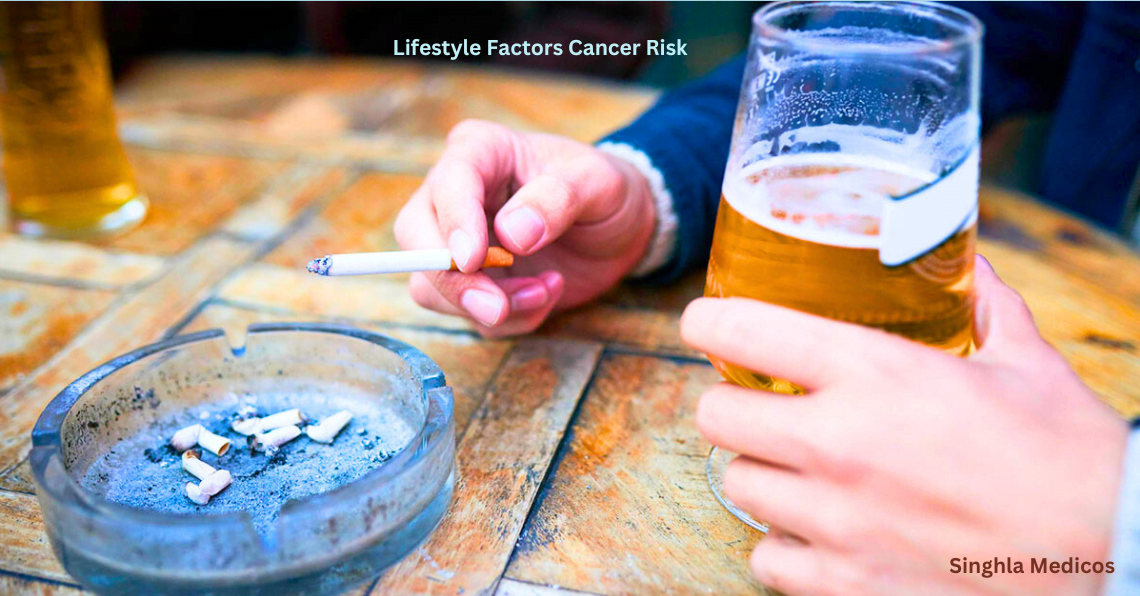BLOG
Lifestyle Factors and Their Influence on Cancer Risk

Lifestyle Factors and Their Influence on Cancer Risk
Cancer remains one of the leading causes of death worldwide, with millions of new cases diagnosed each year. While genetics play a significant role in determining cancer risk, lifestyle factors also exert a substantial influence. By understanding and modifying certain behaviors and habits, individuals can significantly reduce their risk of developing cancer. This blog explores key lifestyle factors that influence cancer risk and provides insights on how to make healthier choices.
Diet and Nutrition
A balanced diet rich in fruits, vegetables, whole grains, and lean proteins is crucial for maintaining overall health and reducing cancer risk. Diets high in processed foods, red meats, and sugary beverages have been linked to an increased risk of various cancers, including colorectal, breast, and prostate cancer.
Fruits and vegetables contain essential vitamins, minerals, and antioxidants that help protect cells from damage. Fiber-rich foods like whole grains aid in digestion and help prevent colorectal cancer. Conversely, consuming large amounts of red and processed meats, which are often high in saturated fats and preservatives, has been associated with higher cancer risk. Incorporating more plant-based foods and reducing intake of harmful substances can thus be a proactive step towards cancer prevention.
Physical Activity
Regular physical activity is another important factor in cancer prevention. Exercise helps regulate body weight, improve immune function, and reduce inflammation, all of which are critical in reducing cancer risk. Sedentary lifestyles have been linked to an increased risk of several cancers, including breast, colon, and endometrial cancer.
Engaging in moderate to vigorous physical activity for at least 150 minutes per week can significantly lower the risk of these cancers. Activities such as walking, cycling, swimming, and strength training are beneficial. Moreover, integrating physical activity into daily routines, like opting for stairs over elevators or walking instead of driving short distances, can make a substantial difference.
Tobacco Use
Tobacco use is the leading preventable cause of cancer worldwide. Smoking is directly responsible for approximately 22% of cancer deaths, particularly lung cancer, which is the most common cause of cancer-related death. In addition to lung cancer, smoking is linked to cancers of the mouth, throat, esophagus, pancreas, bladder, and cervix, among others.
Quitting smoking and avoiding exposure to secondhand smoke are critical steps in reducing cancer risk. Numerous resources, including counseling, medications, and support groups, are available to help individuals quit smoking. The benefits of quitting smoking are substantial, with risk reductions starting as soon as a few months after cessation and continuing to decrease over time.
Alcohol Consumption
Excessive alcohol consumption is another significant risk factor for cancer. Alcohol is classified as a Group 1 carcinogen by the International Agency for Research on Cancer (IARC), meaning it is a known cause of cancer in humans. Alcohol consumption is linked to cancers of the mouth, throat, esophagus, liver, breast, and colon.
To reduce cancer risk, it is advisable to limit alcohol intake to no more than one drink per day for women and two drinks per day for men. Abstaining from alcohol or drinking in moderation can help lower the risk of developing alcohol-related cancers.
Sun Exposure
Excessive sun exposure and the use of tanning beds increase the risk of skin cancers, including melanoma, which is the most dangerous form. Ultraviolet (UV) radiation from the sun can damage the DNA in skin cells, leading to mutations and cancer.
Protecting skin from harmful UV rays by using sunscreen with a high SPF, wearing protective clothing, and avoiding peak sun hours (10 AM to 4 PM) can help prevent skin cancer. Regular skin checks for new or changing moles or spots are also crucial for early detection and treatment.
Weight Management
Maintaining a healthy weight is essential for reducing the risk of various cancers. Obesity is associated with an increased risk of several cancers, including breast, colon, endometrial, kidney, and pancreatic cancer. Excess body fat can lead to increased levels of insulin and estrogen, which can promote the growth of cancer cells.
Adopting a balanced diet and regular physical activity are key strategies for achieving and maintaining a healthy weight. Monitoring weight, setting realistic goals, and seeking professional guidance if necessary can aid in weight management and cancer prevention.
Conclusion
While genetics and environmental factors play roles in cancer development, lifestyle choices significantly impact cancer risk. By adopting a healthy diet, engaging in regular physical activity, avoiding tobacco and excessive alcohol, protecting skin from UV radiation, and maintaining a healthy weight, individuals can greatly reduce their cancer risk. Awareness and proactive lifestyle changes are powerful tools in the fight against cancer, empowering individuals to take control of their health and well-being.More

